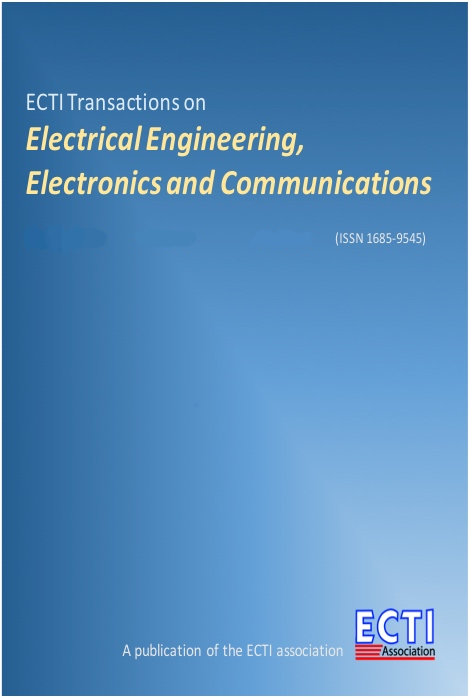BER Performance Investigation of WPM with Unknown CSI Using Time-Domain MMSE Equalization
Main Article Content
Abstract
Wavelet Packet Modulation (WPM) is an emerging Multi-Carrier Modulation (MCM) technique regarded as a potential alternative to widely used Orthogonal Frequency Division multiplexing (OFDM). OFDM uses Cyclic Prex (CP) and can rely on one-tap equalization. Since WPM has overlapping symbols in the time domain, equalization cannot depend on the use of CP. This paper considers time-domain Minimum Mean-Square Error (MMSE) equalization for WPM with unknown Channel State Information (CSI), where equalizer filter coefficients are computed using known training sequences. The infuence of the transmission overhead due to training sequences on the Bit Error Rate (BER) performance is investigated considering quasistatic time-varying Rayleigh fading channels. Numerical results from computer simulations show that, with moderate overhead due to training sequences, BER performances are comparable with the case of known CSI. Furthermore, WPM is compared to OFDM with one-tap equalization, and is shown to provide better BER performances as compared to OFDM. Finally, this paper demonstrates improvement in Peak-to-Average Power Ratio (PAPR) of the transmitted signal using subcarrier combining for WPM in heterogeneous communication environments, where low-rate and high-rate devices share the same transmission resources.
Article Details
This journal provides immediate open access to its content on the principle that making research freely available to the public supports a greater global exchange of knowledge.
- Creative Commons Copyright License
The journal allows readers to download and share all published articles as long as they properly cite such articles; however, they cannot change them or use them commercially. This is classified as CC BY-NC-ND for the creative commons license.
- Retention of Copyright and Publishing Rights
The journal allows the authors of the published articles to hold copyrights and publishing rights without restrictions.
References
M. Gautier and J. Lienard, "Efficient wavelet packet modulation for wireless communication," Proceeding of Advanced International Conference on Telecommunications (AICT), Mauritius, 2007.
A. Habibi, "Introduction to wavelets," Proceeding of MILCOM, USA, pp. 879-885, 1995.
A. R. Lindsey, "Wavelet packet modulation for orthogonally multiplexed communication,"IEEE Transactions on Signal Processing, vol. 45, no. 5, pp. 1336-1339, 1997.
B.G. Negash and H. Nikookar, "Wavelet-based multicarrier transmission over multipath wireless channels," Electronics Letters, vol. 36, no. 21, pp. 1787-1788, 2000.
B. Torun, M.K. Lakshmanan, and H. Nikookar, "On the analysis of peak-to-average power ratio of wavelet packet modulation," Proceeding of European Wireless Technology Conference, Italy, 2009.
A. Jamin and P. Mahonen, "Wavelet packet modulation for wireless communications," Wireless Communications and Mobile Computing Journal, vol. 5, no. 2, pp. 123-137, 2005.
B. Torun, M.K. Lakshmanan, and H. Nikookar, "Peak-to-average power ratio reduction of wavelet packet modulation by adaptive phase selection," Proceeding of IEEE PIMRC, Turkey, 2010.
M. Gautier et al., "PAPR analysis in wavelet packet modulation," Proceeding of IEEE ISCCSP, Malta, 2008.
H. Xian, T. Gewei, X. Qingyong, X. Ning, and W. Shuangxi, "A kind of PAPR reduction method based on pruning WPM and PTS technology," Journal of Electronics(China), vol. 30, no. 3, 2013.
J. Zakaria and M.F.M. Salleh, "PAPR reduction scheme: wavelet packet-based PTS with embedded side information data scheme, " IET Communications, vol. 11, no. 1, pp.127-135, 2016.
S. Gracias and V.U. Reddy, "An equalization algorithm for wavelet packet based modulation schemes," IEEE Transactions on Signal Processing, vol. 46, no. 11, pp. 3082-3087, 1998.
A. Bajpai, M.K. Lakshmanan, and H. Nikookar, "Channel equalization in wavelet packet modulation by minimization of peak distortion," Proceeding of IEEE PIMRC, Canada, pp. 152-156, 2011.
U. Khan, S. Baig, and M.J. Mughal, "Performance comparison of wavelet packet modulation and OFDM for multipath wireless channel,"
Proceeding of IEEE International Conference on Computer, Control and Communication (IC4), Pakistan, 2009.
Z. Mohammadi et al., "Recovery of ISI channels with wavelet packet modulation using linear equalization and channel estimation," Proceeding of International Symposium On I/V Communications and Mobile Network (ISVC), Morocco, 2010.
M.K. Gupta and S. Tiwari, "Performance evaluation of conventional and wavelet based OFDM system," International Journal of Electronics and Communication (AEU), vol. 67, no. 4, pp. 348-354, 2013.
ITU-R Rec. M.1225, Guidelines for evaluation of radio transmission technologies for IMT-2000, 1997.
C.S. Burrus, R.A. Gopinath, and H. Guo, Introduction to wavelets and wavelet transform, Prentice-Hall, 1998.
C.R. Johnson, W.A. Sethares, and A.G. Kelvin, Software receiver design, Cambridge University Press, 2011.
J.G. Proakis and M. Salehi, Digital Communications, 5th ed., McGraw-Hill, 2008.
J.G. Andrews, A. Ghosh, and R. Muhamed, Fundamentals of WiMAX: Understanding Broadband Wireless Networking, Prentice-Hall, 2007.
A. Goldsmith, Wireless Communications, Cambridge University Press, 2005.
D. Tse, Fundamentals of Wireless Communications, Cambridge University Press, 2005.
K. Kumar and A. Grover, "Comparison of block type pilot channel estimation techniques for evaluating the performance of OFDM," International Journal of Scientific & Engineering Research, vol. 3, no. 11, 2012.

